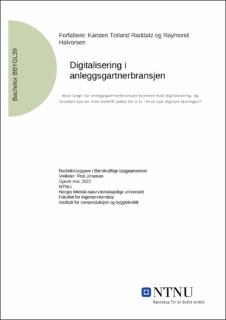| dc.contributor.advisor | Johansen, Fred | |
| dc.contributor.author | Raddatz, Karsten Totland | |
| dc.contributor.author | Halvorsen, Raymond | |
| dc.date.accessioned | 2022-07-01T17:19:21Z | |
| dc.date.available | 2022-07-01T17:19:21Z | |
| dc.date.issued | 2022 | |
| dc.identifier | no.ntnu:inspera:106257255:112786513 | |
| dc.identifier.uri | https://hdl.handle.net/11250/3002142 | |
| dc.description.abstract | Denne bacheloroppgaven i byggeledelse er en avsluttende oppgave på studiet Bærekraftige byggeprosesser. Studiet er lokalisert på NTNU Gjøvik og ligger under Institutt for vareproduksjon og byggteknikk. Det er lagt opp som et fleksibelt studium og tilrettelagt for å kombinere studier med fulltidsarbeid.
Studiet baserer seg på at det er et stort behov for kvalifisert arbeidskraft innenfor forvaltning, saksbehandling, prosjektstyring, økonomi og ledelse. Studiet har gitt oss grunnleggende forståelse for teknologiske utfordringer knyttet til BAE-næringen (Bygg, Anlegg og Eiendom) og dens byggeprosesser, kombinert med økonomi- og ledelsesfag (NTNU - Institutt for vareproduksjon og byggteknikk, u.å.).
Problemstilling for denne oppgaven er selvvalgt og valgt basert på at en av studentene har arbeidet innenfor anleggsgartnerfaget i over 20 år, samt startet opp og drevet anleggsgartnerfirmaet Hageform as i 15 år.
Digitalisering har vært en rød tråd gjennom studiet Bærekraftige byggeprosesser, og temaet har blitt knyttet opp mot hvordan bygg- og anleggsnæringen kan bli mer konkurransedyktig og bærekraftig.
Ettersom studiet Bærekraftige byggeprosesser ikke er et ingeniørstudium er heller ikke bakgrunnen for og gjennomføringen av denne oppgaven skrevet fra et ingeniørfaglig perspektiv. Denne oppgaven er utarbeidet med bakgrunn i et ledelsesperspektiv og studieplanen til Bærekraftige byggeprosesser (NTNU - Institutt for vareproduksjon og byggteknikk, u.å.).
Vi ønsker å takke våre intervjukandidater og veileder Fred Johannesen for deres bidrag. Videre ønsker vi å takke SmartDok for å gi oss tilgang til deres innsamlede datagrunnlag fra spørreundersøkelse. | |
| dc.description.abstract | For several years, there has been a focus on digitization in construction, which has been described as a tool for cutting emissions and increasing profitability. Strategy and mapping for digitization are pointed out as important elements for achieving a higher degree of digitization within construction. It also appears that the largest companies have come further with digitalization than the small and medium-sized companies.
The purpose of the thesis is to map which areas may be suitable for being covered by a digital strategy, what opportunities and barriers exist and what the status of these areas is for the industry today.
Thesis question?
How far has the landscape gardening industry come with digitalization, and how can a small company work to implement new digital solutions?
In this thesis, it has been chosen to use method triangulation by combining a survey that covers a large volume with a qualitative interview process with a select few. The idea behind this is that results from the two different approaches can confirm or deny each other.
The results show that a large proportion of the companies have digitized many of the administrative tasks, but few of the practical ones. Surprisingly, few companies think that digitization provides financial gain. Sustainability also does not seem to be a motivating factor. The industry is willing to digitize, but so far the industry is not mature enough to take out potential financial gain or environmental savings.
When implementing digital strategy, there are different approaches, but distinct management and involvement of employees for ownership and motivation seems to be a success factor. | |
| dc.language | nob | |
| dc.publisher | NTNU | |
| dc.title | Digitalisering i anleggsgartnerbransjen | |
| dc.type | Bachelor thesis | |
